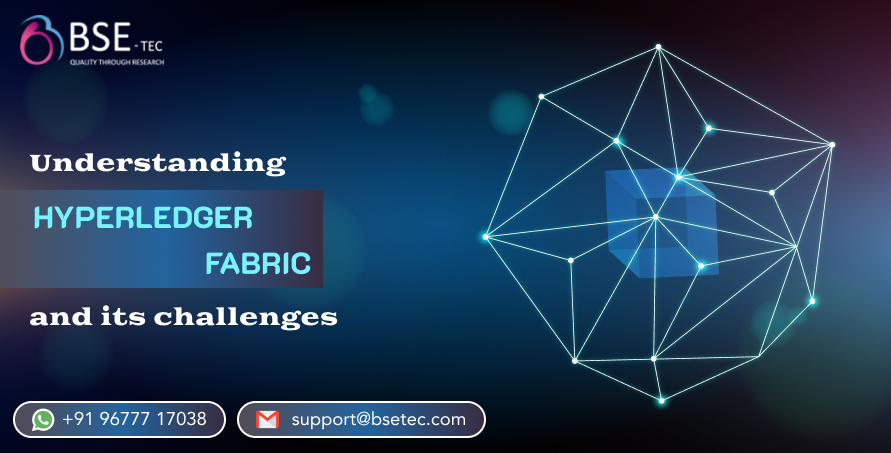Understanding Hyperledger fabric and its challenges

In the fast-evolving world of enterprise blockchain, Hyperledger Fabric has emerged as one of the most reliable and modular frameworks. Backed by the Linux Foundation, it is designed specifically for businesses that need secure, permissioned, and scalable blockchain networks.
In this blog, we’ll dive into what makes Hyperledger Fabric unique, explore its key challenges, and explain how BSEtec is innovating with the latest niche technologies to deliver next-generation blockchain solutions.
What is Hyperledger Fabric?
Hyperledger Fabric is an open-source, permissioned blockchain framework built to meet enterprise requirements for privacy, scalability, and flexibility. Unlike public blockchains like Ethereum or Bitcoin, Fabric allows organizations to control access and visibility among participants.
Key Features of Hyperledger Fabric
- Permissioned Network – Only authorized members can join, ensuring privacy and security.
- Modular Architecture – Supports plug-and-play components for consensus, membership, and ordering services.
- Smart Contracts (Chaincode) – Written in languages like Go, JavaScript, or Java to automate business logic.
- Private Channels & Data Collections – Enables confidential transactions between specific parties.
- Pluggable Consensus Mechanisms – Enterprises can choose consensus protocols based on performance needs.
This modular flexibility makes Fabric ideal for industries like finance, healthcare, supply chain, and logistics where data security and controlled access are crucial.
Benefits of Using Hyperledger Fabric
- Enhanced Privacy: Data is visible only to relevant participants.
- Improved Scalability: Modular design supports high-volume transactions.
- Enterprise Integration: Works well with ERP, CRM, and other business systems.
- Regulatory Compliance: Ideal for industries with strict compliance requirements.
- Transparency & Traceability: Provides an immutable ledger for all business activities.
Real-World Use Cases
Organizations across sectors are leveraging Fabric to solve real challenges:
- Supply Chain: Track product provenance and prevent fraud.
- Finance: Secure trade settlements and interbank transactions.
- Healthcare: Manage medical records and patient consent securely.
- Identity Management: Create tamper-proof digital identity systems.
Challenges in Implementing Hyperledger Fabric
Despite its advantages, Fabric isn’t without obstacles. Here are the main challenges enterprises face:
1. Scalability & Performance
While Fabric’s modular design is flexible, it can struggle with high transaction volumes. The Execute-Order-Validate (EOV) model introduces delays in complex networks, especially when multiple endorsers are required.
2. Complex Governance
In consortium networks, deciding who manages nodes, updates chaincodes, and admits new members can be complicated. Governance policies must be clearly defined early on.
3. Integration Difficulties
Connecting Fabric to existing enterprise systems (like SAP, Salesforce, or Oracle) requires significant customization and expertise.
4. Security & Privacy Concerns
While Fabric is permissioned, vulnerabilities in chaincode, misconfigured peers, or weak key management can create security risks.
5. Talent & Maintenance
Deploying and maintaining Fabric networks demands niche skills — from DevOps and cloud setup to smart contract development and cryptography.
How BSEtec is Transforming Enterprises with Hyperledger Fabric
BSEtec, a leading blockchain development company, specializes in Hyperledger Fabric-based enterprise solutions. By combining technical excellence with real-world use cases, BSEtec empowers organizations to unlock the full potential of blockchain technology.
BSEtec’s Offerings
- End-to-End Blockchain Development – From ideation to deployment and support.
- Custom Chaincode Development – Secure smart contracts tailored to specific business needs.
- Integration Services – Seamless connection between blockchain networks and enterprise systems.
- Security & Compliance Solutions – Ensuring adherence to GDPR, HIPAA, and other regulatory frameworks.
- Training & Consultation – Educating teams and supporting ongoing network maintenance.
Innovative Niche Technologies BSEtec Adopts
- AI + Blockchain Integration – Enhancing trust, predictive analytics, and automation in Fabric networks.
- IoT with Blockchain – Real-time asset tracking using IoT devices integrated with Fabric.
- Hybrid Cloud Blockchain – Deploying Fabric on multi-cloud or hybrid environments for resilience.
- Smart Identity Management – Building privacy-focused identity verification systems.
By focusing on innovation, scalability, and compliance, BSEtec helps enterprises navigate the challenges of blockchain adoption with ease.
Why Choose BSEtec for Hyperledger Fabric Solutions?
- Proven expertise in enterprise-grade blockchain applications.
- Dedicated R&D on Hyperledger ecosystem advancements.
- Deep understanding of business process optimization using blockchain.
- Support for industry-specific templates — supply chain, fintech, and healthcare.
Future of Hyperledger Fabric
The future of Fabric looks promising, with research focusing on:
- Enhanced Consensus Mechanisms.
- Cross-Blockchain Interoperability.
- AI-driven Governance and Automation.
- Improved Scalability via Parallel Transaction Execution.
As Fabric continues to evolve, companies like BSEtec are helping businesses stay ahead of the curve by embracing new upgrades and standards.
Hyperledger Fabric is revolutionizing how enterprises approach transparency, trust, and collaboration. However, success depends on how well organizations handle challenges like governance, scalability, and integration.
With its cutting-edge expertise, industry-specific frameworks, and commitment to innovation, BSEtec is empowering enterprises to harness the full potential of blockchain — securely and efficiently.
If you’re ready to explore blockchain transformation for your business, visit BSEtec’s Hyperledger Solutions to get started.




